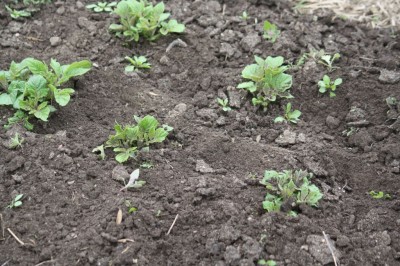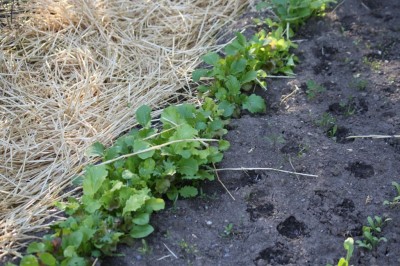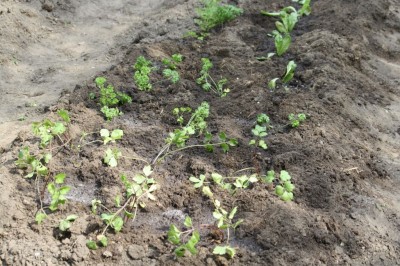by David Hinks
The weather has remained unsettled with some very cool nights. I am still holding off on transplanting into the garden the very frost sensitive plants such as peppers, eggplant, melons and basil. I’m putting the trays outside in the daytime but bringing them in overnight. The forecast for the middle of the week looks like very warm temperatures so out they go into the garden. These babies will have to fend for themselves. The following photos show basil and peppers still happy to be coddled.
Meanwhile some vegetables have been extremely happy with the cooler temperatures. The following photo shows the mesclun mix growing with abandon even after several harvests.
I’ve also been busy the last few days transplanting the vegetables that will withstand some frost such as celery, celeriac and parsley. These join many of the other early frost-tolerant vegetables such as broccoli and Brussels sprouts that were transplanted last week and the onions, garlic, lettuce, spinach and potatoes that have been planted several weeks ago in most cases.
I have planted some vegetable seeds that require relatively warm soil – the beans and beets that I planted last week have yet to poke their heads out. I’ve got my fingers crossed. On Sunday I planted two varieties of winter squash – a butternut squash variety called Avalon and a buttercup type named Sweet Mama. I have had good results with both of these varieties in the past. These are not usually planted in rows but in ‘hills’ of four or so seeds (when packet instructions call for a ‘hill’ this does not mean a mound).
 The plants such as garlic and onions which are continuing to grow very well benefit greatly from not having to compete with weeds. Early weeding should be done on a regular basis probably once a week or every 10 days – a quick pass with a hoe or small cultivator will soon dispatch the weeds that are now germinating.
The plants such as garlic and onions which are continuing to grow very well benefit greatly from not having to compete with weeds. Early weeding should be done on a regular basis probably once a week or every 10 days – a quick pass with a hoe or small cultivator will soon dispatch the weeds that are now germinating.
A couple of weeks ago I wrote about the benefits of using straw as mulch. It cuts down on the amount of hoeing and weeding required particularly in the pathways between the growing beds. The use of mulch also helps to reduce moisture loss. I was finally able to get some bales of straw and have been applying it to the pathways in the vegetable garden. I first pull out any weeds and give the pathway and the edges of the beds a quick hoe before putting a layer of 10 to 15 cm of straw. It is hard to exaggerate the benefits of the mulch. The pathways without mulch were covered with weeds that had germinated after all the rain that we received. Those pathways with some mulch already in place had virtually no weeds.
The potatoes that were planted three or four weeks ago are finally putting on a growth spurt. This is the time to hoe any weeds that are growing around the potatoes but I will let them grow a little taller before I ‘hill’ them up. This is just simply drawing up the soil on both sides of the row of potatoes in order to keep the new growing potatoes from being exposed to the sun. I prefer to use a mulch of about ten cm of straw on the potato beds which helps keep them from being exposed to the sun and it is easier than a lot of hilling-up with a hoe.
 This is also the time to start looking for the dreaded Colorado potato beetle. The adult beetle overwinters in the soil and emerges early in the spring looking for potatoes or its relative eggplant; h
This is also the time to start looking for the dreaded Colorado potato beetle. The adult beetle overwinters in the soil and emerges early in the spring looking for potatoes or its relative eggplant; h
owever it is not going to eat the plants. They will mate and lay their eggs on the underside of the potato plant leaves. When the eggs hatch the pupae are voracious and can strip the leaves off a plant in short order. The easiest stage at which to eliminate the pest is when the adults are first spotted. They can be easily hand-picked and tossed into a bucket of soapy water. It is also worthwhile to flip over the leaves to see if any of the yellow eggs have been laid. The pupae are small and extremely numerous and by far the hardest stage at which to kill the pest. I will be taking photos of them soon unless by some miracle they fail to appear.
One of the reasons that I started these columns was because I believe that the knowledge of how to grow our food is not being passed on from generation to generation so that many young people who become committed to growing food have no practical knowledge base to draw upon. This really struck me this last week. I was planting potatoes and an older man and a young boy stopped as they were walking by. The gentleman asked what I was planting and explained that he would like his grandson to learn how things grow. I explained that I was planting potatoes and he expressed surprise that I was actually placing small potatoes in the row, not realizing that that is how potatoes are ordinarily grown. When I think about it does make some sense, after all we don’t bury small tomatoes in the ground if we want to grow tomatoes. But it did show me graphically that not everyone grew up with gardening parents or grandparents and there is much to learn.







